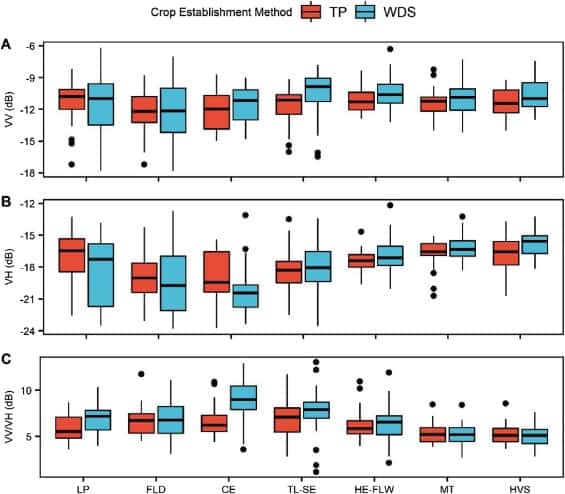Identifying Rice Establishment Method using Sentinel-1 Data

Two different rice establishment methods: transplanting (left) and direct seeding (right). Credit: Andy Nelson
Farmers’ choice of rice establishment method (i.e., transplanting versus direct seeding) have implications on the management of water, weed, disease, season length, farm labor, as well as the methane emission. Direct observation is challenging at large scale, as there is only a short duration in the field when the establishment method is clearly distinguishable, thus indirect detection has been explored. A recently published study, Discriminating transplanted and direct seeded rice using Sentinel-1 intensity data, co-authored by Andy Nelson from University of Twente/ITC and Alice Laborte and Nasreen Islam Khan from IRRI, used the multi-temporal Sentil-1 intensity data to discriminate rice establishment methods. As the first published study with Sentinel-1, the authors identified the most optimum growth stages to detect the rice establishment method across different land management activities.
Abstract
Improved rice crop and water management practices that make the sustainable use of resources more efficient are important interventions towards a more food secure future. A remote sensing-based detection of different rice crop management practices, such as crop establishment method (transplanting or direct seeding), can provide timely and cost-effective information on which practices are used as well as their spread and change over time as different management practices are adopted. Establishment method cannot be easily observed since it is a rapid event, but it can be inferred from resulting observable differences in land surface characteristics (i.e. field condition) and crop development (i.e. delayed or prolonged stages) that take place over a longer time. To examine this, we used temporal information from Synthetic Aperture Radar (SAR) backscatter to detect differences in field condition and rice growth, then related those to crop establishment practices in Nueva Ecija (Philippines). Specifically, multi-temporal, dual-polarised, C-band backscatter data at 20m spatial resolution was acquired from Sentinel-1A every 12 days over the study area during the dry season, from November 2016 to May 2017. Farmer surveys and field observations were conducted in four selected municipalities across the study area in 2017, providing information on field boundaries and crop management practices for 61 fields. Mean backscatter values were generated per rice field per SAR acquisition date. We matched the SAR acquisition dates with the reported dates for land management activities and with the estimated dates for when the crop growth stages occurred. The Mann-Whitney U test was used to identify significant differences in backscatter between the two practices during the land management activities and crop growth stages. Significant differences in cross-polarised, co-polarised and band ratio backscatter values were observed in the early growing season, specifically during land preparation, crop establishment, rice tillering and stem elongation. These findings indicate the possibility to discriminate crop establishment methods by SAR at those stages, suggesting that there is more opportunity for discrimination than has been presented in previous studies. Further testing in a wider range of environments, seasons, and management practices should be done to determine how reliably rice establishment methods can be detected. The increased use of dry and wet direct seeding has implications for many remote sensing-based rice detection methods that rely on a strong water signal (typical of transplanting) during the early season.
Fikriyah, V.N., Darvishzadeh, R., Laborte, A., Khan, N.I. and Nelson, A., 2019. Discriminating transplanted and direct seeded rice using Sentinel-1 intensity data. International Journal of Applied Earth Observation and Geoinformation, 76, pp.143-153.
May 31, 2019
CGIAR-CSI





